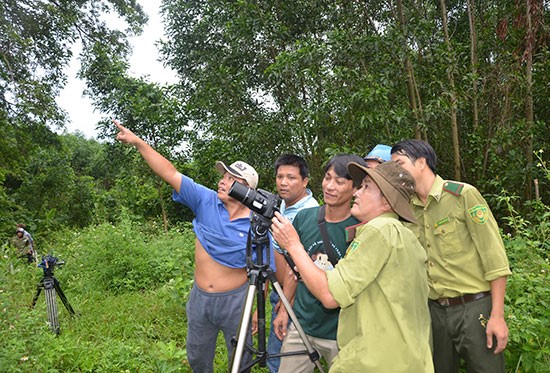Wildlife habitats are enlarged to preserve rare wildlife species in the cooperation between localities. At the same time, a mechanism has been set up to protect the forest ecosystem sustainably, highly adapt to climate change.

Foresters recording gray-shanked doucs
Remote protection
The Forest Protection Department has recently restored forest ecosystems and protected endangered species. The plan on Song Thanh National Park is an example. It is expanded from the Song Thanh Nature Reserve. Besides, the projects on urgent conservation of elephants and enhancing the control and trading of ivory in Vietnam until 2020 in Nong Son district have been carried out. Some others are the Sao La Nature Reserve and the preservation of gray-shanked douc in Tam My Tay commune (Nui Thanh).
The local authorities have helped the residents with their livelihoods, making them not dependent so much on forests any longer. So several rare species are protected from extinction. More than 1,000 ancient trees in Phuoc Son and Nam Giang districts have been delivered to villagers and cared for in special ways. The forests there are digitally mapped for remote management.
In order to prevent the invasion of local residents, the International Fund for Nature launched the project on monitoring biodiversity in special-use forests in Quang Nam. The project also helps the residents understand the human effects on natural populations (consisting of mammals and birds). Besides, the real situation and the changes of forest ecosystems are also analyzed.
According to Mr.Tran Huu Vy, Director of the Green Vietnam Center for Biodiversity Conservation (manager of the project on gray-shanked douc conservation), it is possible to preserve gray-shanked doucs in Nui Thanh if they are in a remote protection. That is, the reserve area for the gray-shanked doucs needs to be enlarged. There should be polices so that the local residents will never touch the “house” of the doucs.
Cross-border forest diversity
In 2018, the Greater Mekong Sub-region Biodiversity Conservation Corridors Project - Phase 2 (BCC project) keeps on bringing benefits to the localities along the borders. The mountainous areas of Quang Nam, Quang Tri and Thua Thien Hue can maintain and restore the ecosystem connectivity there, ensuring sustainable forest ecology and adapting to climate change, creating biodiversity corridors. It also helps to create residents’ livelihood, improve their lives and speed up the local economic development.
In Quang Nam, the BCC project was carried out in Nam Giang and Tay Giang districts with four components (strengthening institutional capacities; restoration, protection and sustainable management of biodiversity corridors; improvement of livelihoods and infrastructure; project management). The project is financed by the Asian Development Bank. Moreover, the Quang Nam provincial People's Committee has lately approved the second phase of the BCC project, which is the good news. The project will ensure the safety for protective and special-use forests thanks to the cross-border cooperation and management of forest ecosystems between the countries (Vietnam, Laos and Cambodia) in the Greater Mekong Sub-region.